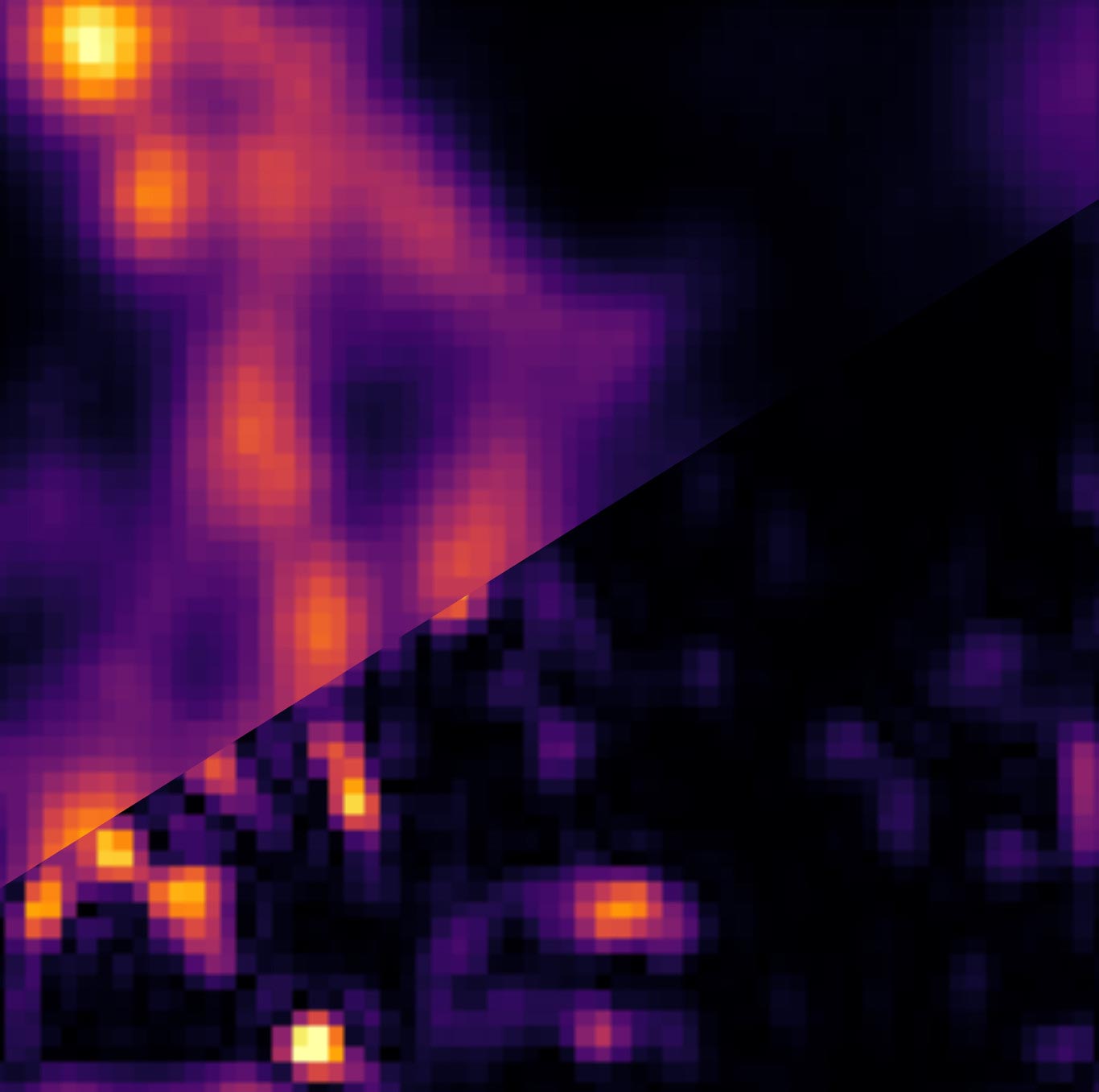Image of microtubules in a fixed cell sample. A 3 micron x 3 micron confocal scan of microtubules in a 3T3 solid cell labeled with quantum dots that have been analyzed in two ways. Above left: image scanning microscopy (ISM), below right: high-resolution optical fluctuation image scanning microscopy (SOFISM) after Fourier reweighting. (Source: UW Physics, A. Makowski).
The Polish-Israeli team from the Faculty of Physics at the University of Warsaw and the Weizmann Institute of Natural Sciences has achieved another major success in fluorescence microscopy. On the pages of the Optica Journal The team presented a new method of microscopy that theoretically has no limit of resolution. In practice, the team was able to demonstrate a quadrupling of the diffraction limit.
The advancement of life sciences and medicine requires the ability to examine ever smaller objects. Scientists need to study the structure and interrelationships of, for example, proteins in cells. At the same time, the observed samples should not differ from the structures naturally occurring in biological organisms, which excludes the use of aggressive methods and reagents.
Although it revolutionized the natural sciences, the classic optical microscope is clearly inadequate today. Due to the wave-like nature of light, an optical microscope does not allow imaging structures that are smaller than approximately 250 nanometers. As a result, objects closer together than half the wavelength of light (which is around 250 nm for green light) cannot be detected. This phenomenon known as the diffraction limit, one of the main obstacles to observing the smallest biological structures, has long been attempted by scientists to overcome.
Electron microscopes offer orders of magnitude better resolution, but only allow the examination of inanimate objects that have to be brought into a vacuum and bombarded with an electron beam. For this reason, electron microscopy cannot be used to study living organisms and the natural processes that take place in them.
This is where fluorescence microscopy comes in, hence the rapid development of high-resolution fluorescence microscopy as a field of physics and the two Nobel Prizes that have already been awarded for related research – in 2008 and 2014.
Various fluorescence microscopy techniques are available today, some of which are widely used in biological imaging. Some methods such as PALM, STORM or STED microscopy are characterized by their ultra-high resolution and enable the detection of objects that are only about a dozen nanometers apart. However, these techniques require long exposure times and a complex process for biological sample preparation. Other techniques such as SIM or ISM microscopy are easy to use, but offer very limited improvement in resolution, which allows structures to be identified that are only half the size of the diffraction limit.
Aleksandra Sroda, Adrian Makowski and Dr. Radek Lapkiewicz from the Quantum Optics Lab of the Faculty of Physics at the University of Warsaw, in cooperation with the team of Prof. Dan Oron from the Weizmann Institute of Science in Israel, introduced a new super-technology called Super-Resolution Optical Fluctuation Image Scanning Microscopy (SOFISM).
In SOFISM, the naturally occurring fluctuations in the emission intensity of fluorescent markers are used to further improve the spatial resolution of an image scanning microscope (ISM). ISM, an emerging super-resolution method, has already been implemented in commercial products and has proven valuable to the bio-imaging community. For the most part, as it achieves a modest improvement in lateral resolution (x2), with very few changes to the optical setup and without the usual handicap of long exposure times. Thus it enables a natural extension of the capabilities of a standard confocal microscope. ISM uses a confocal microscope in which a single detector is replaced by a detector array.
In SOFISM, correlations of intensities are calculated, which are recorded by several detectors. In principle, the measurement of the nth order correlation can lead to an improvement in the resolution by a factor of 2n in relation to the diffraction limit. In practice, the resolution that can be achieved for higher order correlations is limited by the signal-to-noise ratio of the measurements.
“SOFISM is a compromise between ease of use and resolution. We believe our method will fill the niche between the complex, hard-to-use, very high-resolution techniques and the easy-to-use, lower-resolution methods. SOFISM has no theoretical limit of resolution, and in our article we show results that are four times better than the diffraction limit. We also show that the SOFISM method has a high potential for mapping three-dimensional biological structures, ”said Dr. Radek Lapkiewicz.
It is crucial that SOFISM is very accessible in its technical aspects, since only a small modification of the widely used confocal microscope is required and the photomultiplier tube is replaced by a SPAD array detector. In addition, the measurement time has to be slightly increased and the data processing method changed. “Until recently, SPAD array detectors were expensive and their specifications were insufficient for correlation-based microscopy. That situation has recently changed. The new SPAD detectors introduced last year have removed both technological and price barriers. This leads us to believe that fluorescence microscopic techniques such as SOFISM could be widely used in the field of microscopic examination in a few years ”, emphasized Dr. Lapkiewicz.
Reference: “SOFISM: High-resolution optical fluctuation image scanning microscopy” by Aleksandra Sroda, Adrian Makowski, Ron Tenne, Uri Rossman, Gur Lubin, Dan Oron and Radek Lapkiewicz, September 29, 2020, Optica.
DOI: 10.1364 / OPTICA.399600
The project was carried out under the FIRST TEAM program of the Polish Science Foundation.



